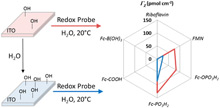Publication
766
Langmuir, 31 (6), 1931-1940, 2015
DOI:10.1021/la503760x
|
|
|
|
|
|
 |
Efficient chemisorption of organophosphorous redox probes on indium tin oxide surfaces under mild conditions |
|
|
|
Amélie Forget, Benoît Limoges, and Véronique Balland
Laboratoire d’Electrochimie Moléculaire, UMR CNRS 7591, Université Paris Diderot, Sorbonne Paris Cité, 15 rue Jean-Antoine de Baïf, F-75205 Paris, Cedex 13, France
We report a mild and straightforward one-step chemical surface functionalization of indium tin oxide (ITO) electrodes by redox-active molecules bearing an organophosphoryl anchoring group (i.e., alkyl phosphate or alkyl phosphonate group). The method takes advantage of simple passive adsorption in an aqueous solution at room temperature. We show that organophosphorus compounds can adsorb much more strongly and stably on an ITO surface than analogous redox-active molecules bearing a carboxylate or a boronate moiety. We provide evidence, through quantitative electrochemical characterization (i.e., by cyclic voltammetry) of the adsorbed organophosphoryl redox-active molecules, of the occurrence of three different adsorbate fractions on ITO, exhibiting different stabilities on the surface. Among these three fractions, one is observed to be strongly chemisorbed, exhibiting high stability and resistance to desorption/hydrolysis in a free-redox probe aqueous buffer. We attribute this remarkable stability to the formation of chemical bonds between the organophosphorus anchoring group and the metal oxide surface, likely occurring through a heterocondensation reaction in water. From XPS analysis, we also demonstrate that the surface coverage of the chemisorbed molecules is highly affected by the degree of surface hydroxylation, a parameter that can be tuned by simply preconditioning the freshly cleaned ITO surfaces in water. The lower the relative surface hydroxide density on ITO, the higher was the surface coverage of the chemisorbed species. This behavior is in line with a chemisorption mechanism involving coordination of a deprotonated phosphoryl oxygen atom to the non-hydroxylated acidic metal sites of ITO. |

